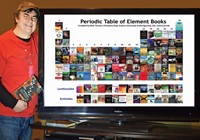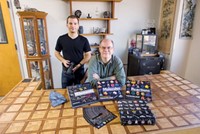Advertisement
Grab your lab coat. Let's get started
Welcome!
Welcome!
Create an account below to get 6 C&EN articles per month, receive newsletters and more - all free.
It seems this is your first time logging in online. Please enter the following information to continue.
As an ACS member you automatically get access to this site. All we need is few more details to create your reading experience.
Not you? Sign in with a different account.
Not you? Sign in with a different account.
ERROR 1
ERROR 1
ERROR 2
ERROR 2
ERROR 2
ERROR 2
ERROR 2
Password and Confirm password must match.
If you have an ACS member number, please enter it here so we can link this account to your membership. (optional)
ERROR 2
ACS values your privacy. By submitting your information, you are gaining access to C&EN and subscribing to our weekly newsletter. We use the information you provide to make your reading experience better, and we will never sell your data to third party members.
Physical Chemistry
Movers And Shakers
Theodore Gray
Element enthusiast talks about making a periodic table for the 21st century
by Bethany Halford
November 26, 2007
| A version of this story appeared in
Volume 85, Issue 48
FIVE YEARS AGO Theodore W. Gray had a kooky idea for a conference table: Build a table in the shape of the periodic table, complete with samples for each element. The oddball project propelled Gray into the spotlight, making the software developer an unlikely spokesman for chemistry. Nevertheless, Gray took to the task with aplomb. He now writes a monthly column for Popular Science, is the creator of a stunning periodic table poster, and hosts two element-themed websites—theodoregray.com/PeriodicTable and periodictable.com.
A cautionary note to readers: While both of Gray's websites provide a quick guide to any elemental data you might need, you'll probably find yourself spending far more time there than you intended. Gray's tales of sodium engine valves, homemade phosphorus matches, and silky hafnium lumps are irresistibly entertaining, providing endless online distraction.
Gray says his personal website started as a natural outgrowth of his element-collecting hobby. "I had put a few objects in the periodic table table, and I thought, 'If I don't write down where those came from, a few years from now I'm going to have forgotten.' So I just started keeping little notes for myself about where each sample came from, what it was, and why it was there," Gray says. "Once I had collected three or four dozen such descriptions I thought, 'Well, I better put this on a website,' because that's what you do when you have anything these days—you put it on your own website."
Gray's element collection has since grown to 1,472 samples and counting, including rainbow-colored bismuth crystals, 40-lb silicon boules, and a chunk of depleted uranium metal. "There's just nothing you can't find on eBay," he quips.
Each sample is meticulously documented on both websites, including rotating video loops of many of the objects, each compiled from 360 high-resolution photos taken at 1° increments. Gray used to take all the photos himself, but he recently brought on someone to help with photography, bookkeeping, and accounting. You know your hobby has gotten out of hand when you have to hire an assistant, Gray observes.
Gray's original goal for making the video loops was to assemble them into an animated periodic table video. Looking at the video, with its sleek black background and dazzling element images, it occurred to Gray that he'd assembled a very attractive periodic table poster. So he had the poster manufactured and started selling it on his website.
Eventually, though, Gray decided that while his personal website was perfectly fine for documenting his element collection and selling his poster, he wanted to do something more. He wanted to build an intuitive and definitive online resource for the elements—a place where students, teachers, scientists, and element enthusiasts could easily go to find out about the periodic table and everything on it. In short, he decided it was his destiny to create periodictable.com, which went online this month.
"There are many things that have to come together to make a site like this possible, and 10 or 15 years ago quite a number of those things didn't exist," he explains. "You need to have the technology for taking pictures in a cost-effective way, and you need the Internet because there's no way you could afford to publish a book with all these photographs in it.
"You also need to have the computational infrastructure to make it practical to put this all together and to make an attractive, well-operating website," he adds. To that end, all of the content on periodictable.com has been generated by or processed through Mathematica, a computer program from Wolfram Research, the company Gray cofounded and still works for.
WITH PERIODICTABLE.COM, Gray uses the Internet to breathe life into the elements. A wristwatch glows with luminous radium paint; light gleams off the bearings in a titanium hip joint; a glass bulb captures the rusty hue of bromine gas. Gray has built a periodic table for the 21st century, and in doing so, he has become chemistry's ambassador to the Internet generation.
"I didn't set out to be anything like that," Gray says. Still, he's aware that both his websites and his Popular Science column make him a champion of science to the general public. "What I think is important is that people understand why it is that science is different from most other things out there," Gray says. "People are growing up with no idea that science is actually different from political punditry, different from people spouting opinions.
"Science actually tells you things that are true, not just things that are somebody's opinion," he continues. "The way that you find the truth is to apply the scientific method. You don't just make stuff up. You try it and you see what happens, which is the fundamental core of what science is all about. I think that's something that the public needs to hear more often."






Join the conversation
Contact the reporter
Submit a Letter to the Editor for publication
Engage with us on Twitter